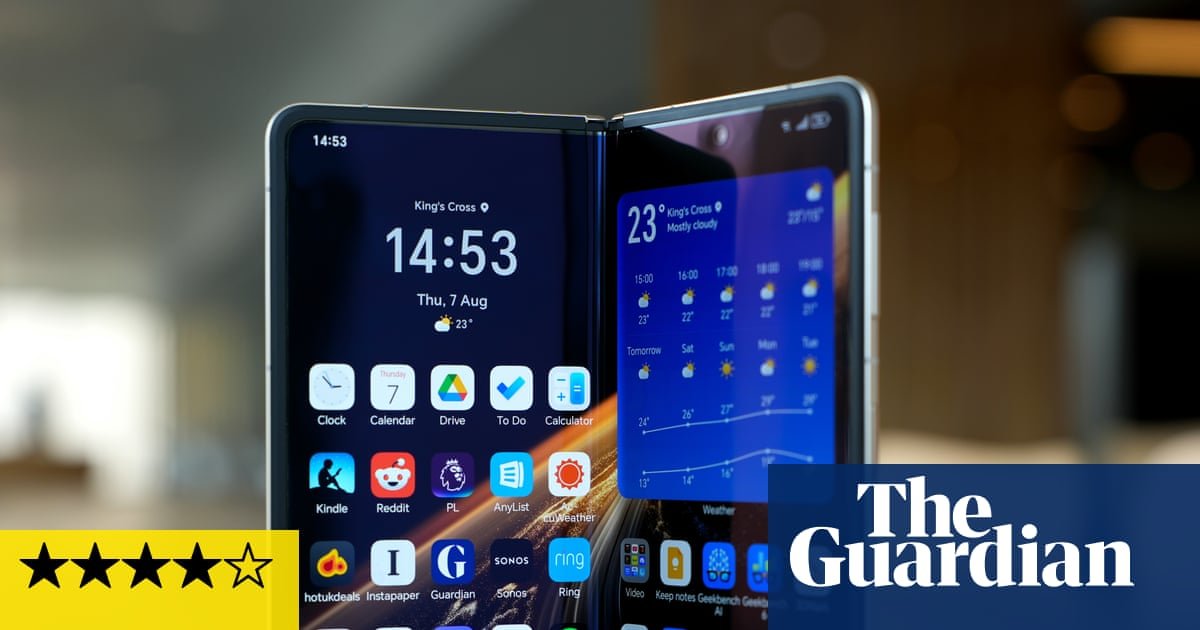AI Research
Honor Magic V5 review: fantastic foldable phone that needs better Android software | Smartphones

Honor’s latest foldable phone-tablet attempts to usurp Samsung as the leader of the pack with a super-thin body, massive battery and a ginormous camera lump on the back.
The Magic V5 is an impressively thin piece of engineering, slimmed down to about 8.9mm thick when shut, with each half about the same thickness as a USB-C port. It feels very similar to a standard slab phone in the hand, but one you can open up like a book for a mini-tablet on the go.
The foldable costs £1,699.99 (€1,999.99), undercutting the competition from Samsung and Google by up to £100, but still very much at the eye-wateringly expensive end of the smartphone market.
The Magic V5 comes in various colours with different materials on the back that make the phone varying thicknesses and weights. At 222g or under it is slightly heavier than Samsung’s latest Fold 7, but far lighter than the rest of the folding phone competition, and about the same weight as a large slab phone.
The outside 6.43in OLED screen is great and acts just like a regular phone while the inside 7.95in folding screen is one of the best, with an impressive brightness. It still has a crease down the middle but you don’t notice it in use. The inside screen is necessarily softer than traditional phone screens to allow it to bend, so you have to treat it with care; and it is a fingerprint magnet.
The Honor is one of the first folding phones to be water- and dust-resistant to similar standards as a regular phone. That means fine particles shouldn’t be able to get behind the moving, flexible screen and metal hinge, which has been a durability concern for all foldables.
Specifications
-
Main screen: 7.95in (403ppi) 120Hz OLED flexible display
-
Cover screen: 6.43in (405ppi) 120Hz OLED
-
Processor: Qualcomm Snapdragon 8 Elite
-
RAM: 16GB
-
Storage: 512GB
-
Operating system: MagicOS 9.0.1 (Android 15)
-
Camera: 50MP + 50MP ultrawide + 64MP 3x tele; 2x 20MP selfie
-
Connectivity: 5G, dual sim + esim, USB-C, wifi 7, NFC, Bluetooth 6, GNSS
-
Water resistance: IP58 and IP59 (immersion and high pressure jets)
-
Dimensions folded: 156.8 x 74.3 x 8.88-9mm
-
Dimensions unfolded: 156.8 x 145.9 x 4.1-4.2mm
-
Weight: 217-222g
Top Snapdragon chip and a high-capacity battery
The Magic V5 has Qualcomm’s current top Android chip, the Snapdragon 8 Elite, matching rivals and flagship phones. It feels responsive in day-to-day activities, plays games very well and doesn’t get too hot when pushed hard.
But that power is best used when multitasking, as you can run up to four apps on screen at once – half as many as Samsung’s Fold 7 but more than enough to actually be able to use.
More impressive is the high-capacity battery Honor has managed to squeeze into the svelte frame, which is larger than most big slab phones, let alone folders. That means the battery life is great, but as with other folding phones it varies a lot depending on which screen you use most. Used primarily as a tablet for browsing and watching video with four hours of 5G usage, the Magic V5 lasts a good 37 hours between charges. With more balanced usage across the two screens it lasts into a third day before running out of juice.
MagicOS software still needs work
The Magic V5 runs Honor’s MagicOS 9, which is based on last year’s Android 15 rather than the latest Android 16. But Honor will provide seven years of Android version and security updates for devices sold within Europe, which is a dramatic improvement over previous efforts, and similar in length to its main rivals.
The software has some good ideas, but as with previous versions it still has some rough areas and irritating behaviours. The outside screen works mostly like any other Android phone with Gemini and various other AI tools. But it is on the inside screen where the software shines and irritates. You can place three apps in a splitscreen at once, with one of them pushed partially off the side of the screen to provide more space for the other two without quitting it. Tapping it brings it back on to the screen to use it. It’s a smart idea first seen on the OnePlus Open. A button on the taskbar makes arranging your multiple windows easy.
But tap on an app notification on the inside screen and the system insists on opening the app in a mini-window, even if you wanted it to be full screen. That might be fine for smaller messaging apps such as WhatsApp, but I never want to open Gmail or larger-format apps in tiny windows that then need to be tapped a couple more times to fill the full screen.
The software also doesn’t make good use of the partially folded modes that the inside screen can adopt, lacking an equivalent to Samsung’s good Flex mode, which seems like a wasted opportunity. Another bug in the typeface on the Honor makes it very difficult to see which emails are unread in bold in Gmail, which is extremely irritating.
Much of these little annoyances would be acceptable on cheaper smartphones, but not on a £1,700, ultra-premium device. Honor still has work to do.
Camera
The Magic V5 has a decent set of cameras housed in an enormous round camera lump that protrudes from the rear of the phone. The main 50-megapixel camera shoots good-looking images across a range of lighting conditions, though it can become a bit soft with weaker indoor lighting.
The 50MP ultra-wide camera is solid, but displays a bit of warping around the edges of the scene and lacks a bit of fine detail. The 64MP 3x optical telephoto camera is the best of the bunch, with good detail and colour, even in indoor lighting. It can manage a 6x in-sensor zoom, which is a bit softer on detail when viewed at full size but works well in bright light, plus digital zoom up to 100x that remains fairly decent up to about 20x magnification.
The two 20MP selfie cameras are good enough, but you get much better results using the main camera and the outside screen for a viewfinder.
The camera has many different modes to play around with including a smart motion capture system that handles action photography and solid video capture. It also has a lot of AI and enhancement features that are common to Chinese smartphones modifying the appearance of faces and the alike should you wish.
Overall the camera is one of the better ones on a foldable, though it can’t match the best cameraphones on the market.
Sustainability
The battery has an expected lifespan of at least 1,200 full-charge cycles with at least 80% of its original capacity. The Magic V5 is generally repairable by Honor, with internal screens costing about £700 or external screens about £200 to replace out of warranty. Honor offers a free screen repair for 12 months if bought within the first month of release.
The device contains some recycled plastic. Honor publishes limited environmental reports and offers trade-in and refurbished products.
Price
The Honor Magic V5 costs £1,699.99 (€1,999.99).
For comparison, the Samsung Galaxy Z Fold 7 costs from £1,799, the Google Pixel 10 Pro Fold costs £1,749, the Galaxy S25 Ultra costs £1,249 and the Honor Magic 7 Pro costs £1,099.
Verdict
Yet again Honor has produced some exquisite folding phone hardware that is let down by its software. MagicOS has improved over the last few years, but it lacks much of the customisation and capabilities possible on rivals.
The biggest problem is that it lacks polish, with rough patches or irritating behaviours across the system. None of them is a deal-breaker, but they build up and can’t be overlooked on a £1,700 phone.
It’s a shame as the phone is fast, the battery life is great, the camera is highly capable and it looks fabulous. It’s good to see Samsung and Google get some meaningful competition in book-style foldables. But at about the same price as the market leader, Samsung, there’s little reason to pick the Magic V5 over it.
Pros: super-slim phone and tablet in one, light, just like a normal phone when closed, great performance, very long battery life, good internal screen, decent camera, good fingerprint scanner, water and dust resistance rating.
Cons: very expensive, software not as refined as needed with irritating behaviours, more fragile than a regular device, costly to repair, limited folding modes.
AI Research
Lessons from 60 Years in Journalism — A Postscript on Artificial Intelligence – TAPinto
AI Research
Tories pledge to get ‘all our oil and gas out of the North Sea’

Conservative leader Kemi Badenoch has said her party will remove all net zero requirements on oil and gas companies drilling in the North Sea if elected.
Badenoch is to formally announce the plan to focus solely on “maximising extraction” and to get “all our oil and gas out of the North Sea” in a speech in Aberdeen on Tuesday.
Reform UK has said it wants more fossil fuels extracted from the North Sea.
The Labour government has committed to banning new exploration licences. A spokesperson said a “fair and orderly transition” away from oil and gas would “drive growth”.
Exploring new fields would “not take a penny off bills” or improve energy security and would “only accelerate the worsening climate crisis”, the government spokesperson warned.
Badenoch signalled a significant change in Conservative climate policy when she announced earlier this year that reaching net zero would be “impossible” by 2050.
Successive UK governments have pledged to reach the target by 2050 and it was written into law by Theresa May in 2019. It means the UK must cut carbon emissions until it removes as much as it produces, in line with the 2015 Paris Climate Agreement.
Now Badenoch has said that requirements to work towards net zero are a burden on oil and gas producers in the North Sea which are damaging the economy and which she would remove.
The Tory leader said a Conservative government would scrap the need to reduce emissions or to work on technologies such as carbon storage.
Badenoch said it was “absurd” the UK was leaving “vital resources untapped” while “neighbours like Norway extracted them from the same sea bed”.
In 2023, then Prime Minister Rishi Sunak granted 100 new licences to drill in the North Sea which he said at the time was “entirely consistent” with net zero commitments.
Reform UK has said it will abolish the push for net zero if elected.
The current government said it had made the “biggest ever investment in offshore wind and three first of a kind carbon capture and storage clusters”.
Carbon capture and storage facilities aim to prevent carbon dioxide (CO2) produced from industrial processes and power stations from being released into the atmosphere.
Most of the CO2 produced is captured, transported and then stored deep underground.
It is seen by the likes of the International Energy Agency and the Climate Change Committee as a key element in meeting targets to cut the greenhouse gases driving dangerous climate change.
AI Research
Dogs and drones join forest battle against eight-toothed beetle

Esme Stallard and Justin RowlattClimate and science team
 Sean Gallup/Getty Images
Sean Gallup/Getty ImagesIt is smaller than your fingernail, but this hairy beetle is one of the biggest single threats to the UK’s forests.
The bark beetle has been the scourge of Europe, killing millions of spruce trees, yet the government thought it could halt its spread to the UK by checking imported wood products at ports.
But this was not their entry route of choice – they were being carried on winds straight over the English Channel.
Now, UK government scientists have been fighting back, with an unusual arsenal including sniffer dogs, drones and nuclear waste models.
They claim the UK has eradicated the beetle from at risk areas in the east and south east. But climate change could make the job even harder in the future.
The spruce bark beetle, or Ips typographus, has been munching its way through the conifer trees of Europe for decades, leaving behind a trail of destruction.
The beetles rear and feed their young under the bark of spruce trees in complex webs of interweaving tunnels called galleries.
When trees are infested with a few thousand beetles they can cope, using resin to flush the beetles out.
But for a stressed tree its natural defences are reduced and the beetles start to multiply.
“Their populations can build to a point where they can overcome the tree defences – there are millions, billions of beetles,” explained Dr Max Blake, head of tree health at the UK government-funded Forestry Research.
“There are so many the tree cannot deal with them, particularly when it is dry, they don’t have the resin pressure to flush the galleries.”
Since the beetle took hold in Norway over a decade ago it has been able to wipe out 100 million cubic metres of spruce, according to Rothamsted Research.
‘Public enemy number one’
As Sitka spruce is the main tree used for timber in the UK, Dr Blake and his colleagues watched developments on continental Europe with some serious concern.
“We have 725,000 hectares of spruce alone, if this beetle was allowed to get hold of that, the destructive potential means a vast amount of that is at risk,” said Andrea Deol at Forestry Research. “We valued it – and it’s a partial valuation at £2.9bn per year in Great Britain.”
There are more than 1,400 pests and diseases on the government’s plant health risk register, but Ips has been labelled “public enemy number one”.
The number of those diseases has been accelerating, according to Nick Phillips at charity The Woodland Trust.
“Predominantly, the reason for that is global trade, we’re importing wood products, trees for planting, which does sometimes bring ‘hitchhikers’ in terms of pests and disease,” he said.
Forestry Research had been working with border control for years to check such products for Ips, but in 2018 made a shocking discovery in a wood in Kent.
“We found a breeding population that had been there for a few years,” explained Ms Deol.
“Later we started to pick up larger volumes of beetles in [our] traps which seemed to suggest they were arriving by other means. All of the research we have done now has indicated they are being blown over from the continent on the wind,” she added.
 Daegan Inward/Forestry Research
Daegan Inward/Forestry ResearchThe team knew they had to act quickly and has been deploying a mixture of techniques that wouldn’t look out of place in a military operation.
Drones are sent up to survey hundreds of hectares of forest, looking for signs of infestation from the sky – as the beetle takes hold, the upper canopy of the tree cannot be fed nutrients and water, and begins to die off.
But next is the painstaking work of entomologists going on foot to inspect the trees themselves.
“They are looking for a needle in a haystack, sometimes looking for single beetles – to get hold of the pioneer species before they are allowed to establish,” Andrea Deol said.
In a single year her team have inspected 4,500 hectares of spruce on the public estate – just shy of 7,000 football pitches.
Such physically-demanding work is difficult to sustain and the team has been looking for some assistance from the natural and tech world alike.
 Tony Jolliffe/BBC
Tony Jolliffe/BBCWhen the pioneer Spruce bark beetles find a suitable host tree they release pheromones – chemical signals to attract fellow beetles and establish a colony.
But it is this strong smell, as well as the smell associated with their insect poo – frass – that makes them ideal to be found by sniffer dogs.
Early trials so far have been successful. The dogs are particularly useful for inspecting large timber stacks which can be difficult to inspect visually.
The team is also deploying cameras on their bug traps, which are now able to scan daily for the beetles and identify them in real time.
“We have [created] our own algorithm to identify the insects. We have taken about 20,000 images of Ips, other beetles and debris, which have been formally identified by entomologists, and fed it into the model,” said Dr Blake.
Some of the traps can be in difficult to access areas and previously had only been checked every week by entomologists working on the ground.
The result of this work means that the UK has been confirmed as the first country to have eradicated Ips Typographus in its controlled areas, deemed to be at risk from infestation, and which covers the south east and east England.
“What we are doing is having a positive impact and it is vital that we continue to maintain that effort, if we let our guard down we know we have got those incursion risks year on year,” said Ms Deol.
 Tony Jolliffe/BBC
Tony Jolliffe/BBCAnd those risks are rising. Europe has seen populations of Ips increase as they take advantage of trees stressed by the changing climate.
Europe is experiencing more extreme rainfall in winter and milder temperatures meaning there is less freezing, leaving the trees in waterlogged conditions.
This coupled with drier summers leaves them stressed and susceptible to falling in stormy weather, and this is when Ips can take hold.
With larger populations in Europe the risk of Ips colonies being carried to the UK goes up.
The team at Forestry Research has been working hard to accurately predict when these incursions may occur.
“We have been doing modelling with colleagues at the University of Cambridge and the Met Office which have adapted a nuclear atmospheric dispersion model to Ips,” explained Dr Blake. “So, [the model] was originally used to look at nuclear fallout and where the winds take it, instead we are using the model to look at how far Ips goes.”
Nick Phillips at The Woodland Trust is strongly supportive of the government’s work but worries about the loss of ancient woodland – the oldest and most biologically-rich areas of forest.
Commercial spruce have long been planted next to such woods, and every time a tree hosting spruce beetle is found, it and neighbouring, sometimes ancient trees, have to be removed.
“We really want the government to maintain as much of the trees as they can, particularly the ones that aren’t affected, and then also when the trees are removed, supporting landowners to take steps to restore what’s there,” he said. “So that they’re given grants, for example, to be able to recover the woodland sites.”
The government has increased funding for woodlands in recent years but this has been focused on planting new trees.
“If we only have funding and support for the first few years of a tree’s life, but not for those woodlands that are 100 or century years old, then we’re not going to be able to deliver nature recovery and capture carbon,” he said.
Additional reporting Miho Tanaka

-
Tools & Platforms3 weeks ago
Building Trust in Military AI Starts with Opening the Black Box – War on the Rocks
-

 Ethics & Policy1 month ago
Ethics & Policy1 month agoSDAIA Supports Saudi Arabia’s Leadership in Shaping Global AI Ethics, Policy, and Research – وكالة الأنباء السعودية
-

 Events & Conferences3 months ago
Events & Conferences3 months agoJourney to 1000 models: Scaling Instagram’s recommendation system
-

 Business2 days ago
Business2 days agoThe Guardian view on Trump and the Fed: independence is no substitute for accountability | Editorial
-

 Jobs & Careers2 months ago
Jobs & Careers2 months agoMumbai-based Perplexity Alternative Has 60k+ Users Without Funding
-

 Funding & Business2 months ago
Funding & Business2 months agoKayak and Expedia race to build AI travel agents that turn social posts into itineraries
-

 Education2 months ago
Education2 months agoVEX Robotics launches AI-powered classroom robotics system
-

 Podcasts & Talks2 months ago
Podcasts & Talks2 months agoHappy 4th of July! 🎆 Made with Veo 3 in Gemini
-

 Podcasts & Talks2 months ago
Podcasts & Talks2 months agoOpenAI 🤝 @teamganassi
-

 Jobs & Careers2 months ago
Jobs & Careers2 months agoAstrophel Aerospace Raises ₹6.84 Crore to Build Reusable Launch Vehicle



